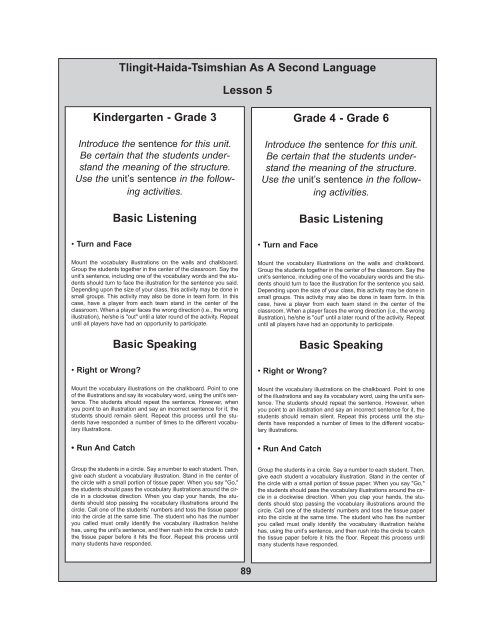Download - Sealaska Heritage Institute
Download - Sealaska Heritage Institute
Download - Sealaska Heritage Institute
You also want an ePaper? Increase the reach of your titles
YUMPU automatically turns print PDFs into web optimized ePapers that Google loves.
Tlingit-Haida-Tsimshian As A Second Language<br />
Lesson 5<br />
Kindergarten - Grade 3<br />
Introduce the sentence for this unit.<br />
Be certain that the students understand<br />
the meaning of the structure.<br />
Use the unit’s sentence in the following<br />
activities.<br />
• Turn and Face<br />
Basic Listening<br />
Mount the vocabulary illustrations on the walls and chalkboard.<br />
Group the stu dents together in the center of the classroom. Say the<br />
unit’s sentence, including one of the vo cabulary words and the students<br />
should turn to face the illustration for the sentence you said.<br />
Depending upon the size of your class, this ac tivity may be done in<br />
small groups. This activity may also be done in team form. In this<br />
case, have a player from each team stand in the center of the<br />
classroom. When a player faces the wrong di rection (i.e., the wrong<br />
il lustration), he/she is "out" until a later round of the ac tivity. Repeat<br />
until all players have had an opportunity to participate.<br />
• Right or Wrong<br />
Basic Speaking<br />
Mount the vocabulary illustrations on the chalkboard. Point to one<br />
of the illustra tions and say its vocabulary word, using the unit’s sentence.<br />
The students should repeat the sentence. However, when<br />
you point to an illustration and say an incorrect sentence for it, the<br />
students should remain silent. Repeat this process until the stu -<br />
dents have re sponded a number of times to the dif ferent vocabulary<br />
illustrations.<br />
• Run And Catch<br />
Grade 4 - Grade 6<br />
Introduce the sentence for this unit.<br />
Be certain that the students understand<br />
the meaning of the structure.<br />
Use the unit’s sentence in the following<br />
activities.<br />
• Turn and Face<br />
Basic Listening<br />
Mount the vocabulary illustrations on the walls and chalkboard.<br />
Group the stu dents together in the center of the classroom. Say the<br />
unit’s sentence, including one of the vo cabulary words and the students<br />
should turn to face the illustration for the sentence you said.<br />
Depending upon the size of your class, this ac tivity may be done in<br />
small groups. This activity may also be done in team form. In this<br />
case, have a player from each team stand in the center of the<br />
classroom. When a player faces the wrong di rection (i.e., the wrong<br />
il lustration), he/she is "out" until a later round of the ac tivity. Repeat<br />
until all players have had an opportunity to participate.<br />
• Right or Wrong<br />
Basic Speaking<br />
Mount the vocabulary illustrations on the chalkboard. Point to one<br />
of the illustra tions and say its vocabulary word, using the unit’s sentence.<br />
The students should repeat the sentence. However, when<br />
you point to an illustration and say an incorrect sentence for it, the<br />
students should remain silent. Repeat this process until the stu -<br />
dents have re sponded a number of times to the dif ferent vocabulary<br />
illustrations.<br />
• Run And Catch<br />
Group the students in a circle. Say a number to each student. Then,<br />
give each student a vocabulary illustration. Stand in the cen ter of<br />
the circle with a small portion of tissue paper. When you say "Go,"<br />
the students should pass the vocabulary illustrations around the cir -<br />
cle in a clockwise direction. When you clap your hands, the students<br />
should stop passing the vocabulary illus trations around the<br />
circle. Call one of the students’ numbers and toss the tissue paper<br />
into the circle at the same time. The student who has the number<br />
you called must orally identify the vocabulary illus tration he/she<br />
has, using the unit’s sentence, and then rush into the circle to catch<br />
the tissue paper before it hits the floor. Repeat this pro cess until<br />
many students have responded.<br />
Group the students in a circle. Say a number to each student. Then,<br />
give each student a vocabulary illustration. Stand in the cen ter of<br />
the circle with a small portion of tissue paper. When you say "Go,"<br />
the students should pass the vocabulary illustrations around the cir -<br />
cle in a clockwise direction. When you clap your hands, the students<br />
should stop passing the vocabulary illus trations around the<br />
circle. Call one of the students’ numbers and toss the tissue paper<br />
into the circle at the same time. The student who has the number<br />
you called must orally identify the vocabulary illus tration he/she<br />
has, using the unit’s sentence, and then rush into the circle to catch<br />
the tissue paper before it hits the floor. Repeat this pro cess until<br />
many students have responded.<br />
89
















